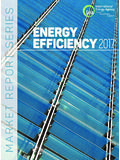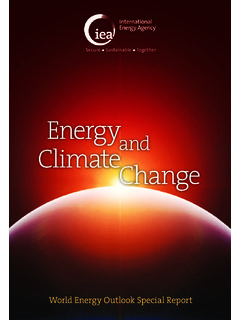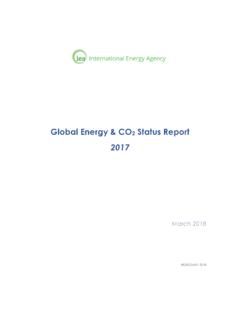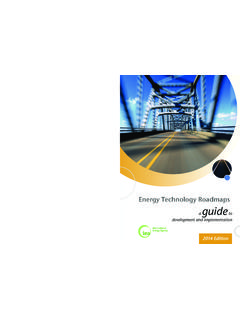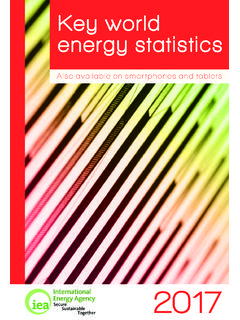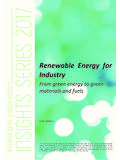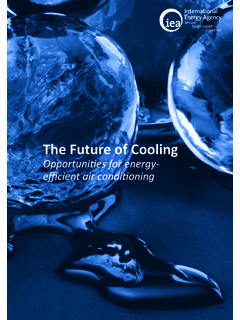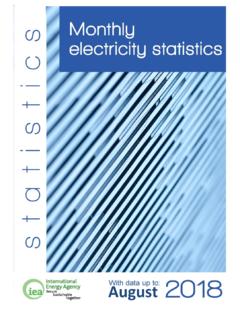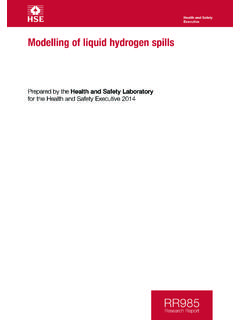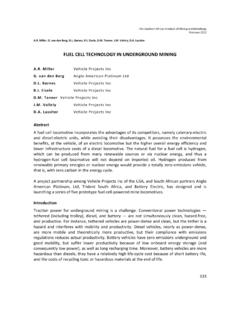Transcription of Technology Roadmap Hydrogen and Fuel Cells
1 2050. 2045. Ene es tiv 2040. rg 2035 Te ec p y chn rs olo g y P e Technology Roadmap Hydrogen and fuel Cells Secure Sustainable Together INTERNATIONAL ENERGY AGENCY. The International Energy Agency (IEA), an autonomous agency, was established in November 1974. Its primary mandate was and is two-fold: to promote energy security amongst its member countries through collective response to physical disruptions in oil supply, and provide authoritative research and analysis on ways to ensure reliable, affordable and clean energy for its 29 member countries and beyond. The IEA carries out a comprehensive programme of energy co-operation among its member countries, each of which is obliged to hold oil stocks equivalent to 90 days of its net imports. The Agency's aims include the following objectives: n Secure member countries' access to reliable and ample supplies of all forms of energy; in particular, through maintaining effective emergency response capabilities in case of oil supply disruptions.
2 N Promote sustainable energy policies that spur economic growth and environmental protection in a global context particularly in terms of reducing greenhouse-gas emissions that contribute to climate change. n Improve transparency of international markets through collection and analysis of energy data. n Support global collaboration on energy Technology to secure future energy supplies and mitigate their environmental impact, including through improved energy efficiency and development and deployment of low-carbon technologies. n Find solutions to global energy challenges through engagement and dialogue with non-member countries, industry, international organisations and other stakeholders. IEA member countries: Australia Austria Belgium Canada Czech Republic Denmark Estonia Finland France Germany Greece Hungary Ireland Italy Japan Korea Luxembourg Netherlands New Zealand Norway Poland Portugal Slovak Republic OECD/IEA, 2015 Spain International Energy Agency Sweden 9 rue de la F d ration 75739 Paris Cedex 15, France Switzerland Turkey United Kingdom Please note that this publication United States is subject to specific restrictions that limit its use and distribution.
3 The European Commission The terms and conditions are also participates in available online at the work of the IEA. Foreword Current trends in energy supply and use Although the GHG mitigation potential of Hydrogen are patently unsustainable economically, technologies is promising, important obstacles for environmentally and socially. Without decisive widespread deployment of Hydrogen and fuel cell action, energy-related emissions of carbon dioxide technologies need to be overcome. These barriers (CO2) will more than double by 2050 and increased are mainly related to current costs of fuel Cells and fossil energy demand will heighten concerns over electrolysers, the development of a Hydrogen T&D. the security of supplies. We can and must change and retail network, as well as the cost efficient our current path.
4 However, this will take an energy generation of Hydrogen with a low-carbon footprint. revolution and low-carbon energy technologies will have a crucial role to play. Energy efficiency, Most Hydrogen and fuel cell technologies are still in sources of renewable energy, carbon capture and the early stages of commercialisation and currently storage (CCS), nuclear power and new transport struggle to compete with alternative technologies, technologies will all require widespread deployment including other low-carbon options, due to high if we are to achieve reductions in greenhouse gas costs. Additional attention will be required before (GHG) emissions. Every major country and sector of their potential can be fully realised. Governments the economy must be involved. The task is urgent can help accelerate the development and if we are to make sure that investment decisions deployment of Hydrogen and fuel cell technologies taken now do not saddle us with sub optimal by ensuring continued research, development technologies in the long term.
5 And demonstration (RD&D) funding for Hydrogen generation and conversion technologies, such as Awareness is growing of the need to turn political electrolysers and fuel Cells . This will facilitate early statements and analytical work into concrete action. commercialisation of fuel cell electric vehicles and To drive this forward, in 2008 the G8 requested support demonstration projects for VRE integration the International Energy Agency (IEA) to lead the using Hydrogen -based energy storage applications. development of a series of roadmaps for some of Overcoming risks related to investment in the most important technologies. By identifying infrastructure hinges upon close collaboration the steps needed to accelerate the implementation among many stakeholders, such as the oil and gas of radical Technology changes, these roadmaps industry, utilities and power grid providers, car will enable governments, industry and financial manufacturers, and local, regional and national partners to make the right choices.
6 This will, in turn, authorities. help societies make the right decisions. This publication is produced under my authority as Hydrogen and fuel cell technologies, once they Executive Director of the IEA. are more developed can support climate change and energy security goals in several sectors of the energy system, such as the transport, industry, Maria van der Hoeven buidings and the power sector. Hydrogen can Executive Director connect different energy sectors and energy International Energy Agency transmission and distribution (T&D) networks, and thus increase the operational flexibility of future low-carbon energy systems. It can help to: 1) achieve very low-carbon individual motorised transport; 2) integrate very high shares of variable renewable energy (VRE) into the energy system.
7 3) contribute to the decarbonisation of the industry and the buildings sector. This publication reflects the views of the International Energy Agency (IEA) Secretariat but does not necessarily reflect those of individual IEA member countries. The IEA makes no representation or warranty, express or implied, in respect to the publication's contents (including its completeness or accuracy) and shall not be responsible for any use of, or reliance on, the publication. Foreword 1. Table of contents Foreword 1. Table of contents 2. Acknowledgements 5. Key findings 6. Cross-cutting opportunities offered by Hydrogen and fuel Cells 6. Energy storage and utilisation in transport, industry and buildings 6. Key actions in the next ten years 7. Cross-cutting opportunities offered by Hydrogen and fuel Cells 7.
8 Energy storage and utilisation in transport, industry and buildings 7. Introduction 8. Rationale for Hydrogen and fuel cell technologies 8. Purpose, process and structure of the Roadmap 11. Roadmap scope 11. Technology status today 12. Hydrogen in transport 12. Hydrogen for VRE integration 19. Hydrogen in industry 24. fuel cell Technology in buildings 25. Other niche applications based on fuel cell technologies 27. Key Hydrogen generation technologies 28. Key Hydrogen conversion and storage technologies 30. Vision for deployment to 2050 34. Transport 34. VRE integration 47. Industry 53. Synergies between energy sectors 54. Parameters of key technologies today and in the future as used in the model 56. Hydrogen Technology development: Actions and milestones 58. Data assessment and model development 58.
9 Technology development 59. Policy, regulatory framework and finance: Actions and milestones 64. Hydrogen in transport 65. Hydrogen in stationary applications 66. The role of codes and standards 67. Finance 68. International collaboration 69. Social acceptance and safety 69. 2 Technology Roadmap Hydrogen and fuel Cells Conclusion: Near-term actions for stakeholders 70. Abbreviations, acronyms and units of measurement 72. References 73. List of figures Figure 1. Energy system today and in the future 10. Figure 2. Well-to-wheel (WTW) emissions vs. vehicle range for several Technology options 14. Figure 3. Cumulative cash flow curve of Hydrogen stations in the early market phase 17. Figure 4. T. oday's carbon footprint for various Hydrogen pathways and for gasoline and compressed natural gas in the European Union 18.
10 Figure 5. Electricity storage applications and technologies 20. Figure 6. Current conversion efficiencies of various Hydrogen -based VRE integration pathways 21. Figure 7. Limitations on the blend share of Hydrogen by application 23. Figure 8. Ene-Farm fuel cell micro co-generation cumulative sales, subsidies and estimated prices, 2009-14 27. Figure 9. Schematic representation of Technology development potential of different electrolysers 29. Figure 10. Production volumes of fuel Cells according to application 30. Figure 11. Production cost for PEMFCs for FCEVs as a function of annual production 31. Figure 12. Energy-related carbon emission reductions by sector in the ETP 2DS 34. Figure 13. PLDV stock by Technology for the United States, EU 4 and Japan in the 2DS high H2 36.
